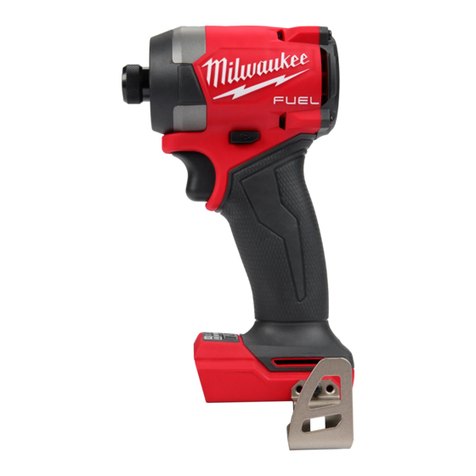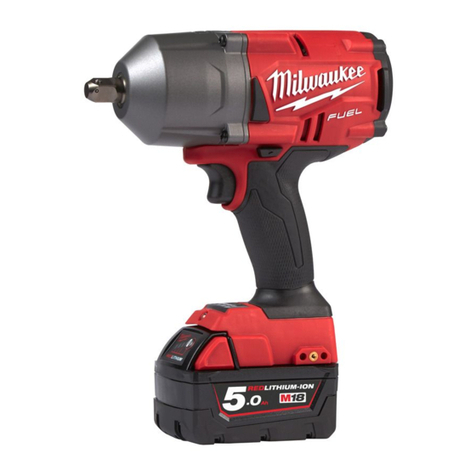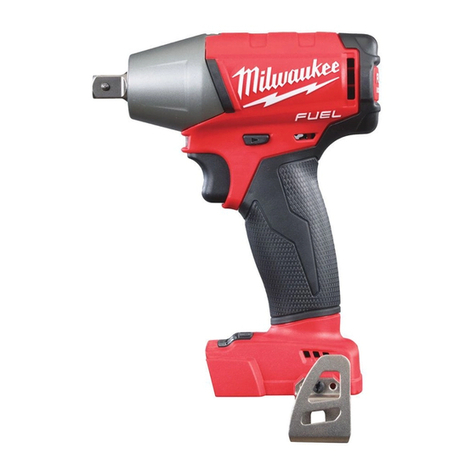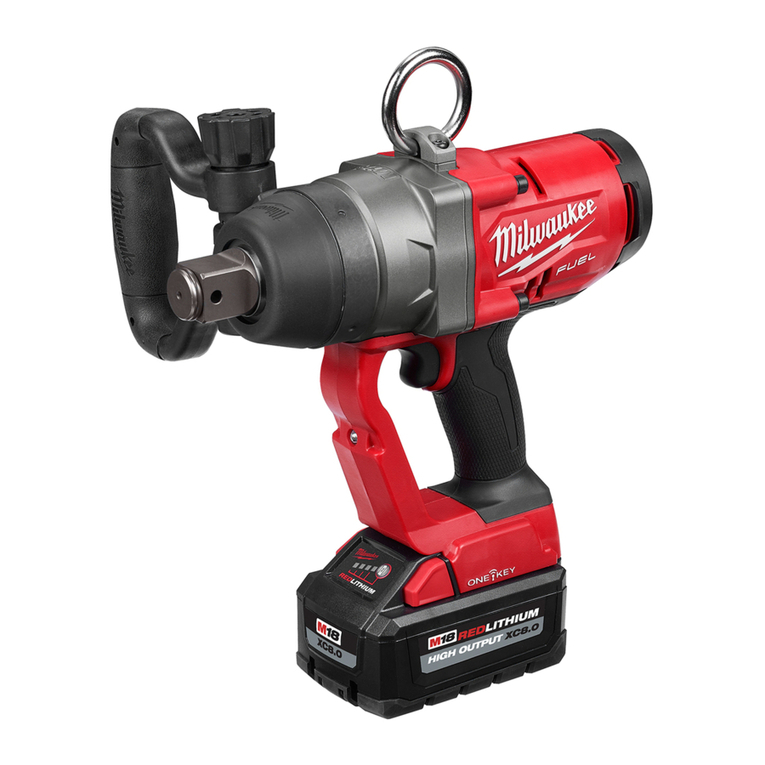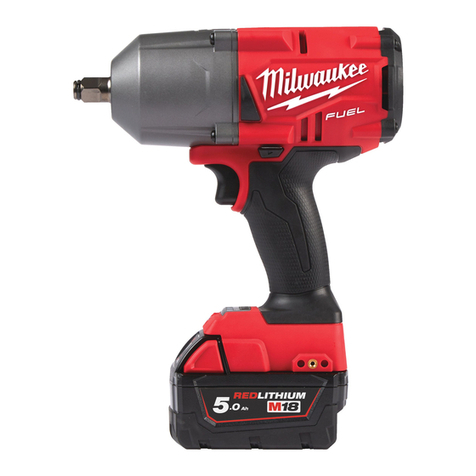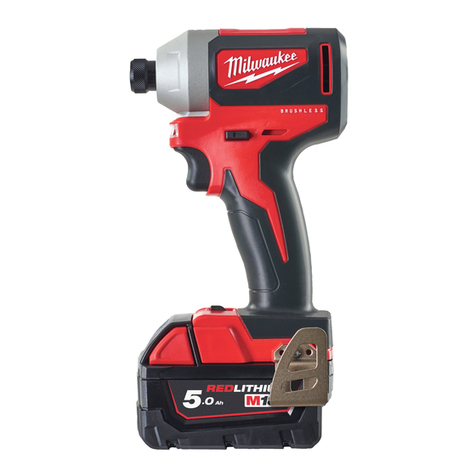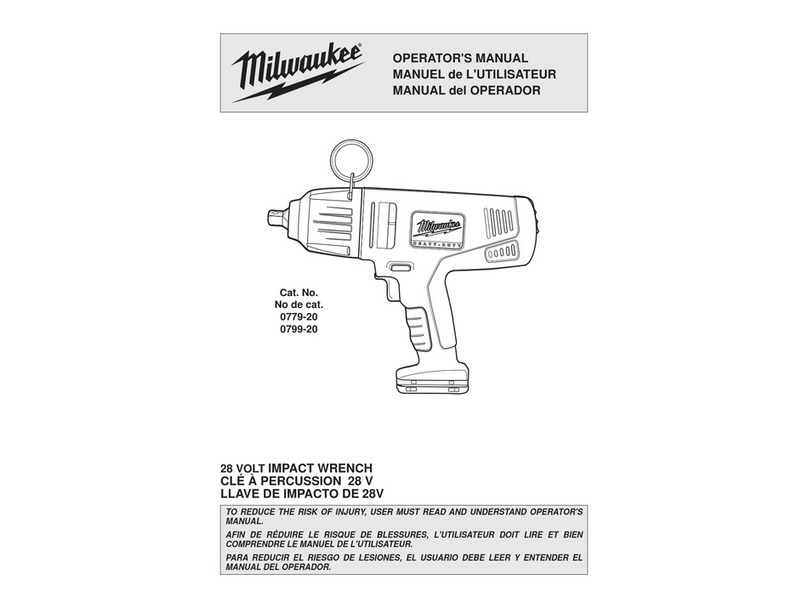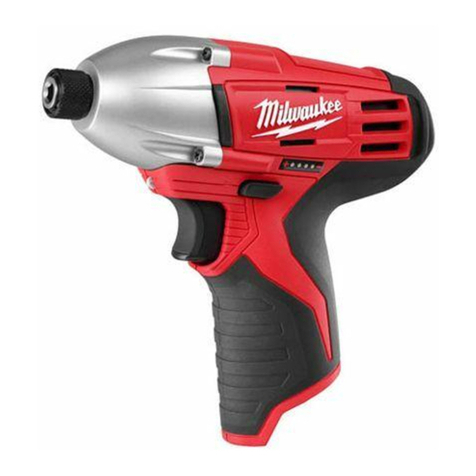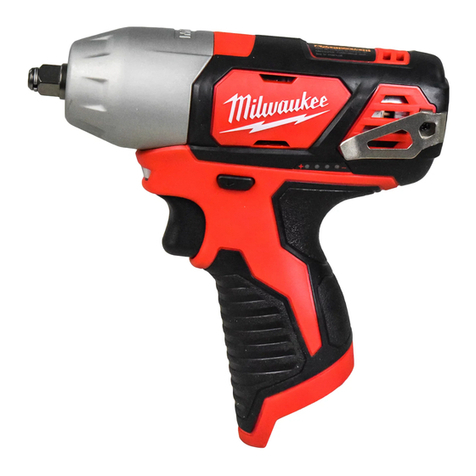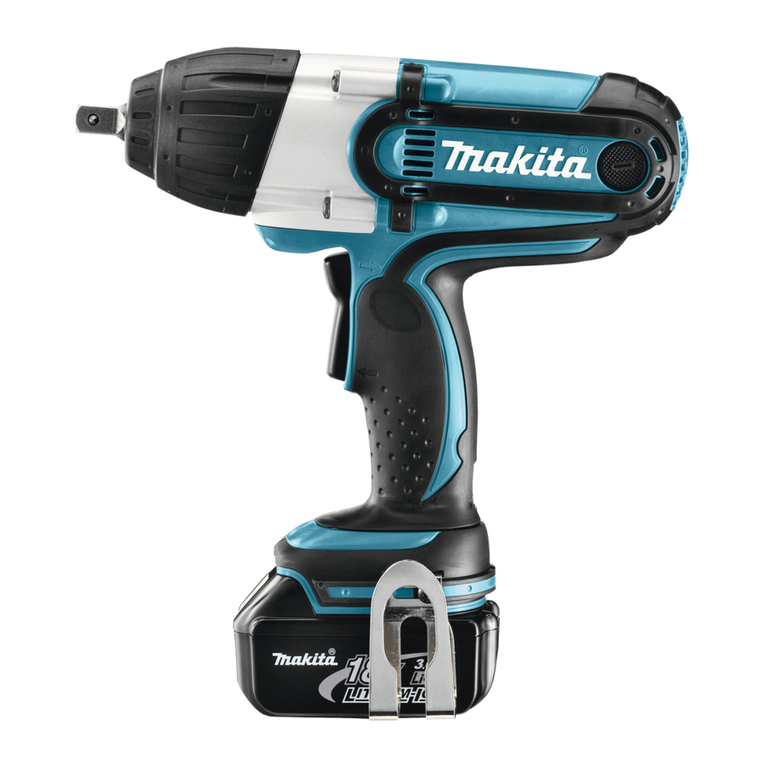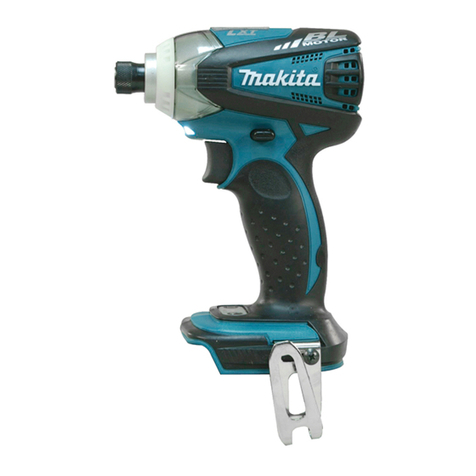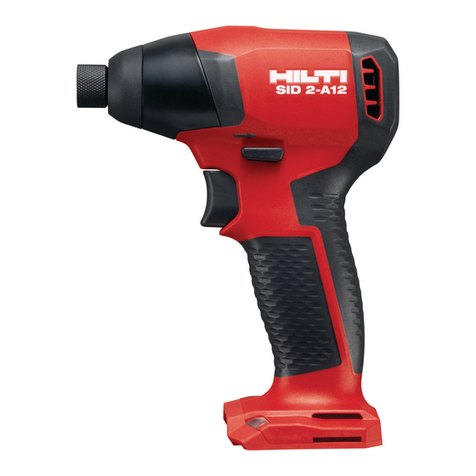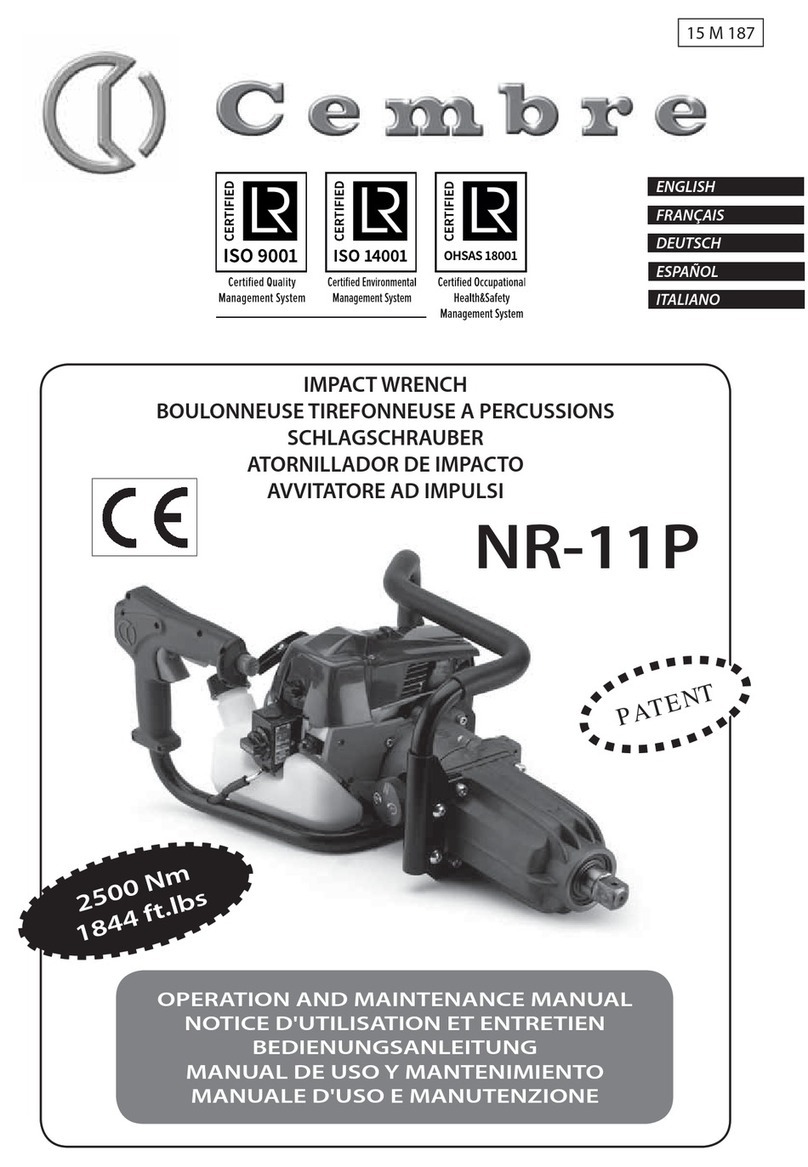
that can make a connection from one terminal to
another. Shorting the batteryterminalstogether may
cause burns or a re.
•Under abusive conditions, liquid may be ejected
from the battery; avoid contact. If contact ac-
cidentally occurs, ush with water. If liquid con-
tacts eyes, additionally seek medical help. Liquid
ejected from the battery may cause irritation or burns.
•Do not use a battery pack or tool that is dam-
aged or modied. Damaged or modied batteries
may exhibit unpredictable behavior resulting in re,
explosion or risk of injury.
•Do not expose a battery pack or tool to re or
excessive temperature. Exposure to re or tem-
perature above 265°F (130°C) may cause explosion.
•Follow all charging instructions and do not
charge the battery pack or tool outside the
temperature range specied in the instructions.
Charging improperly or at temperatures outside the
specied range may damage the battery and increase
the risk of re.
SERVICE
• Have your power tool serviced by a qualied
repair person using only identical replacement
parts. This will ensure that the safety of the power
tool is maintained.
• Never service damaged battery packs. Service
of battery packs should only be performed by the
manufacturer or authorized service providers.
SPECIFIC SAFETY RULES
FOR IMPACT DRIVER
AND IMPACT WRENCH
• Hold the power tool by insulated gripping sur-
faces, when performing an operation where the
fastener may contact hidden wiring. Fasteners
contacting a “live” wire may make exposed metal
parts of the power tool “live” and could give the
operator an electric shock.
•Wear ear protectors when impact drilling. Expo-
sure to noise can cause hearing loss.
• Use only sockets and other accessories speci-
cally designed for use on impact wrenches and
drivers. Othersockets and accessoriesmight shatter
or break causing injury.
•Maintain labels and nameplates. These carry im-
portant information. If unreadable or missing, contact
a MILWAUKEE service facility for a free replacement.
•
Somedust createdby power sanding,
sawing, grinding, drilling, and other
construction activities contains chemicals known to
cause cancer, birth defects or other reproductive
harm. Some examples of these chemicals are:
•lead from lead-based paint
•crystalline silica from bricks and cement and other
masonry products, and
• arsenic and chromium from chemically-treated lumber.
Your risk from these exposuresvaries,dependingon
how often you do this type of work. To reduce your
exposure to these chemicals: work in a well ventilated
area,and work withapproved safety equipment, such
as those dust masks that are specially designed to
lter out microscopic particles.
SYMBOLOGY
Volts
Direct Current
No Load Revolutions per Minute (RPM)
Impacts per Minute Under Load (IPM)
UL Listing for
Canada and U.S.
SPECIFICATIONS
Volts .............................................................. 18 DC
Battery Type .................................................M18™
Charger Type ................................................M18™
Cat. No...................................................... 2760-20
RPM .......................................................... 0 - 3 000
IPM ........................................................... 0 - 4 000
FUNCTIONAL DESCRIPTION
1. 1/4" Hex drive chuck
2. LED
3. Control switch
4. Trigger
5. Handle
6. Speed control
7. Belt clip
8. Auxiliary bit holder
8
1
2
4
3
7
56
ASSEMBLY
Recharge only with the charger
specied for the battery. For spe-
cic charging instructions, read the operator’s
manual supplied with your charger and battery.
Removing/Inserting the Battery
To remove the battery, push in the release buttons
and pull the battery pack away from the tool.
Always remove battery pack before
changing or removing accesso-
ries. Only use accessories specically recom-
mended for this tool. Others may be hazardous.
To insert the battery, slide the pack into the body
of the tool. Make sure it latches securely into place.
Use only sockets and other acces-
sories specifically designed for
use on impact wrenches and drivers. Other
sockets and accessories might shatter or break
causing injury.
3. To stop thetool, release thetriggerand the electric
brake stops the tool instantly.
Impacting Techniques
The longer a bolt, screw, or nut is impacted, the
tighter it will become. To help prevent damaging the
fasteners or workpieces, avoid excessive impact-
ing. Be particularly careful when impacting smaller
fasteners because they require less impacting to
reach optimum torque.
Practice with various fasteners, noting the length of
time required to reach the desired torque. Check the
tightness with a hand-torque wrench. If the fasteners
are too tight, reduce the impacting time. If they are
not tight enough, increase the impacting time.
Oil, dirt, rust or other matter on the threads or under
the head of the fastener affects the degree of tight-
ness.
The torque required to loosen a fastener averages
75% to 80% of the tightening torque, depending on
the condition of the contacting surfaces.
On light gasket jobs, run each fastener down to a
relatively light torque and use a hand torque wrench
for nal tightening.
Temperature Protection
The tool features internal protections that prevent
damage during extreme cold and overheating.
•
If performance is abnormal in low temperature, pull
thetrigger withno load forabout 10 secondsto warm
up the tool.
•
In extreme cold temperatures, the tool may shut
down. Allow the tool to warm up before use.
•
If performance is abnormal after heavy use, let
the tool cool down for about 30 minutes. Normal
performance will return.
MAINTENANCE
To reduce the risk of injury, always
unplug the chargerand remove the
battery pack from the charger or tool before
performing any maintenance. Never disassemble
the tool, battery pack or charger. Contact a
MILWAUKEE service facility for ALL repairs.
Maintaining Tool
Keep your tool, battery pack and charger in good
repair by adopting a regular maintenance program.
Inspect your tool for issues such as undue noise,
misalignmentor binding ofmovingparts, breakage of
parts, or any other condition that may affect the tool
operation. Return the tool, battery pack, and charger
to a MILWAUKEE service facility for repair. After six
months to one year, depending on use, return the
tool, battery pack and charger to a MILWAUKEE
service facility for inspection.
If the tool does not start or operate at full power with
a fully charged battery pack, clean the contacts on
the battery pack. If the tool still does not work prop-
erly, return the tool, charger and battery pack, to a
MILWAUKEE service facility for repairs.
To reduce the risk of personal in-
jury and damage, never immerse
your tool, battery pack or charger in liquid or
allow a liquid to ow inside them.
Attaching and Removing Accessories
The tool is intended for use with drill and
driver bits.
1. To attach an accessory, press the shank
into the hex drive chuck.
2. To remove the accessory, pull out the
ring and remove the accessory. Re-
lease the ring.
OPERATION
Always remove battery pack before
changing or removing accesso-
ries. Only use accessories specically recom-
mended for this tool. Others may be hazardous.
To reduce the risk of injury, wear safety goggles
or glasses with side shields.
Using the Control Switch
The control switch may be set to three positions:
forward, reverse and lock. Due to a lockout mecha-
nism, the control switch can only be adjusted when
the ON/OFF switch is not pressed. Always allow the
motor to come to a complete stop before using the
control switch.
1. For forward (clockwise) rota- CENTER TO LOCK
Forward Reverse
tion, push the control switch
in the direction shown. Check
the direction of rotation
before use.
2. For reverse (counterclock-
wise) rotation, push the control switch in the
direction shown. Check the direction of rotation
before use.
3. To lock the trigger, push the control switch to the
center position. The trigger will not work when the
control switch is in the locked position.
Alwaysremove the batterypack before performing
maintenance or changing accessories. Always
lock the trigger or remove the battery pack before
storing the tool and any time the tool is not in use.
Selecting Speed
Allow the tool to come to a complete stop before
changing speeds. Press the selector button to
cycle between the settings.
Setting Max RPM
123
2760-20 900 2 100 3 000 Designed for driving
self-tapping screws
in sheet metal †
†The function is designed to reduce screw
stripping, screw breakage, and damage to the
work surface when driving self-tapping screws.
This function is optimized for the most common
materials, including #8-#10 self-tapping screws
between ½”-1” in length and 20-28 gauge sheet
metal.
Starting, Stopping and Controlling Speed
The tool may be operated at any speed from 0 to
full speed.
1. To start the tool, pull the trigger.
NOTE: An LED is turned on when the trigger is pulled.
2. To vary the driving speed, increase or decrease
pressure on the trigger. The further the trigger is
pulled, the greater the speed, up to the maximum
speed set by the speed control. Rely only on high-grade power tools on our virtual shelves.
